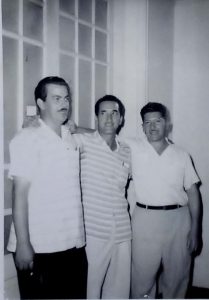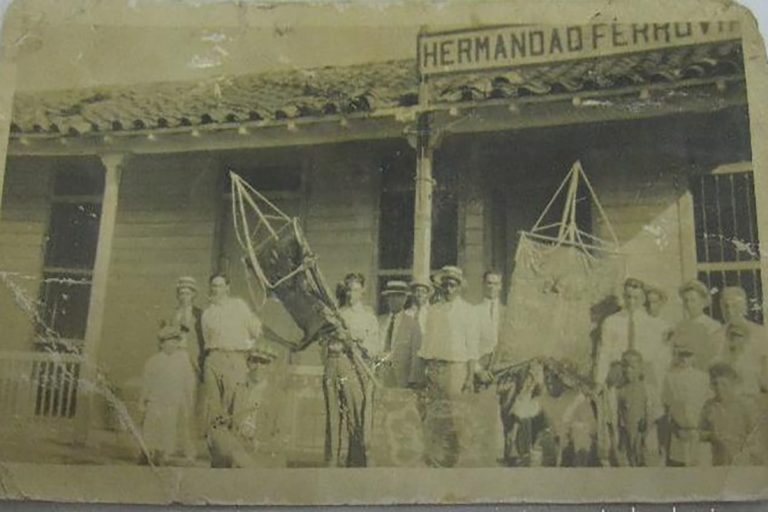As we commemorate a new anniversary of the founding of the town of Santa María del Puerto del Príncipe, we cannot forget that on February 2nd, 1924, “The Railway Brotherhood of Cuba” was established on Santa Rosa Street number 30, heir to “The Railway Brotherhood”, founded on July 6th, 1920. The Cuban Railroad Company engineers, stokers and telegraphists were united within it; their interests were represented before the company through designated delegates of the more than 350 members that made up the organization in its early days.
The notoriety that “The Brotherhood” was achieving within the Cuban railway industry in defense of the Camagüey workers affiliated to it, despite the recognized reformist tendency within the railway union that its first president Andrés Otero Bosch had; It led to the creation of “The Railway Brotherhood of Cuba” in just four years, exceeding the local limits of its predecessor; bringing together workers belonging to different public and private railway companies existing in Cuba.
Since February 2nd itself, delegations from Havana, Santa Clara, Sagua la Grande, Caibarién, Cruces, Cárdenas, Cienfuegos, Matanzas, Puerto Padre joined the two existing companies in Guantánamo and Santiago de Cuba; totaling fourteen nationwide by the end of 1924.
In Camagüey the Central Leadership would fall, and at the head of it was Andrés Otero Bosch, former president of the Camagüey Brotherhood, accompanied by Juan Arévalo as Vice President, who would be in front of delegation number 2 from Havana and Manuel Castellanos as Legal Advisor.
Among its main objectives was to maintain the greatest fraternity between the companies, their employees, workers and thereby be able to prevent them from breaching the duties and rights between both parties. Therefore, they proposed to take part through the delegates in the decisions between the different railway companies and the workers so that with this cooperation they could achieve the material and moral improvement of its associates. This would significantly benefit the living conditions of all railroad workers regardless of their company.
The new organization also sought from its foundation to be able to obtain a greater harmony and interpenetration of ideals among its affiliates, strengthening their ties of cordiality with other worker activities, for example: the Laborers and Stevedores Union of Puerto Tarafa, the Puerto Tarafa Marina Union, with the the Port Section Union of Pastelillo, the Marine and Port Workers Union of Antilla and the Marine Workers Union of Boquerón.
Taking notes
It is important to mention that only two worker groups linked to the railroad and based in the province of Camagüey did not join and remained outside the Brotherhood. “The Union”, founded in 1916 and to which the workers of The Cuba Railroad Company Workshops in Camagüey belonged almost entirely. The other one also called “The Union” grouped the railroad workers of the northern part of Cuba with its center in the city of Morón in 1916.
We can say that two factors were decisive for the founding of “The Railway Brotherhood of Cuba” in 1924, one that since the beginning of operations by The Cuba Railroad Company, the struggle for the demands of the workers belonging to it had its main role in the city of Camagüey from the different labor organizations that were created as of 1902 in the three provinces where their trains ran; that due to its wide network of branches in Las Villas, Oriente and Camagüey was where its administrative center and its workshops were located.
But this variety of groups had repercussions when it came to fighting for the interests of the working class, in a period where the different unions were dominated by reformist elements and served the interests of the company; only “The Union” of the Northern Cuban Railroad, under the direction of Enrique Varona González, was more radical.
A second factor: the need for greater cohesion to fight for their rights among railroad workers, given that since October 1923 the Cuban government had passed the Law of Consolidation of the railway companies based in the province into one. The Consolidated Railroads of Cuba emerged from the union between The Cuba Railroad Company, the Northern Cuban Railroad Company and the Camagüey- Nuevitas Railroad Company on July 28th, 1924, six months after the founding of “The Railway Brotherhood of Cuba”.
The role of the Brotherhood’s struggle was not only framed within the railways, but ignoring the directives of the company leaders, they supported the struggles of all the Cuban people and their oppressed working class, like when they joined and supported the general strike of August 8th, 1933, against the fierce dictatorship of Gerardo Machado, a man who had trampled and repressed the different railway unions existing in the province so many times even before been named president of the republic.
They joined the general strike of March 12th, 1935 along with the Office Employees Union and the Workshops Union against the puppet and submissive provisional government of Colonel Carlos Mendieta and the official for the North American government in Cuba, Fulgencio Batista; as well as during his dictatorship between 1952 and 1958, and many more actions that would fill a long list of their struggles.
Key years
 The years 1959 and 1960 were essential in the Cuban Railroad Brotherhood, first because it knew how to put itself in the right place next to the nascent revolution, firstly removing from their jobs all the yellow leaders and putting it in the hands of prestigious railway workers not only within the Brotherhood, but also the entire railway sector, when on May 11th, 1959, the candidature of the July 26th Movement Rogelio Aróstegui Recio, a veteran fighter of the sector, was elected as president of the Cuban Railway Brotherhood.
The years 1959 and 1960 were essential in the Cuban Railroad Brotherhood, first because it knew how to put itself in the right place next to the nascent revolution, firstly removing from their jobs all the yellow leaders and putting it in the hands of prestigious railway workers not only within the Brotherhood, but also the entire railway sector, when on May 11th, 1959, the candidature of the July 26th Movement Rogelio Aróstegui Recio, a veteran fighter of the sector, was elected as president of the Cuban Railway Brotherhood.
They fully supported the nationalization of the Consolidated Railways of Cuba in October of the same year with a call to continue working for its existence.
An important step taken by the Railroad Brotherhood of Cuba in conjunction with the remaining four railroad collectivities, the Union Railway Workshop, Railroad and United Workers Association, the Office Employees Association and the Inspection Employees Union were integrated into a single organization: The Single Railway Union of Camagüey; as a way to strengthen the union movement. Thus the Brotherhood ceased to function as a trade union.
Translated by: Aileen Álvarez García






